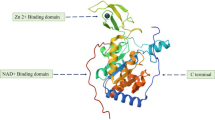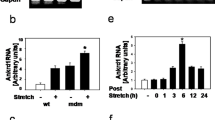Abstract
The activity of protein phosphatase-1 (PP1) inhibitor-1 (I-1) is antithetically modulated by the cAMP-protein kinase A (PKA) and Ca2+-protein kinase C (PKC) signaling axes. β-adrenergic (β-AR) stimulation results in PKA-phosphorylation of I-1 at threonine 35 (Thr35) and depressed PP1 activity, while PKC phosphorylation at serine 67 (Ser67) and/or Thr75 increases PP1 activity. In heart failure, pThr35 is decreased while pSer67 and pThr75 are elevated. However, the role of Ser67/Thr75 phosphorylation in vivo and its effects on Ca2+-cycling are not known. Thus, our aim was to investigate the functional significance of Ser67 and Thr75 phosphorylation in intact hearts. We generated transgenic mice (TG) with cardiac-specific overexpression of constitutively phosphorylated I-1 at Ser67 and Thr75 (S67D/T75D) and evaluated cardiac function. The S67D/T75D cardiomyocytes exhibited significantly depressed Ca2+-kinetics and contractile parameters, compared with wild-type (WT) cells. The decreased Ca2+-cycling was associated with a 27 % increase in PP1 activity, no alterations in PP2 activity and impaired phosphorylation of myosin-binding protein-C (MyBPC). Upon aging, there was cardiac remodeling associated with increases in systolic and diastolic left ventricular internal diameter dimensions (at 16 months), compared with WTs. The results indicate that phosphorylation of I-1 at Ser67 and Thr75 is associated with increased PP1 activity and depressed cardiomyocyte Ca2+-cycling, which manifests in geometrical alterations over the long term. Thus, hyperphosphorylation of these sites in failing hearts may contribute to deteriorative remodeling.







Similar content being viewed by others
References
Aitken A, Bilham T, Cohen P (1982) Complete primary structure of protein phosphatase inhibitor-1 from rabbit skeletal muscle. Eur J Biochem 126:235–246. doi:10.1111/j.1432-1033.1982.tb06771.x
Alcendor RR, Gao S, Zhai P, Zablocki D, Holle E, Yu X, Tian B, Wagner T, Vatner SF, Sadoshima J (2007) Sirt1 regulates aging and resistance to oxidative stress in the heart. Circ Res 100:1512–1521. doi:10.1161/01.RES.0000267723.65696.4a
Anjak A, Koch SE, Jiang MV, Jones WK, Rubinstein J (2011) Age and gender related changes in myocardial function in wild type FVB/N mice evaluated by advanced echocardiography. JASE 24:B7
Bers DM (2002) Cardiac excitation-contraction coupling. Nature 415:198–205. doi:10.1038/415198a
Boengler K, Schulz R, Heusch G (2009) Loss of cardioprotection with ageing. Cardiovasc Res 83:247–261. doi:10.1093/cvr/cvp033
Bowling N, Walsh RA, Song G, Estridge T, Sandusky GE, Fouts RL, Mintze K, Pickard T, Roden R, Bristow MR, Sabbah HN, Mizrahi JL, Gromo G, King GL, Vlahos CJ (1999) Increased protein kinase C activity and expression of Ca2+-sensitive isoforms in the failing human heart. Circulation 99:384–391. doi:10.1161/01.CIR.99.3.384
Boyle AJ, Shih H, Hwang J, Ye J, Lee B, Zhang Y, Kwon D, Jun K, Zheng D, Sievers R, Angeli F, Yeghiazarians Y, Lee R (2011) Cardiomyopathy of aging in the mammalian heart is characterized by myocardial hypertrophy, fibrosis and a predisposition towards cardiomyocyte apoptosis and autophagy. Exp Gerontol 46:549–559. doi:10.1016/j.exger.2011.02.010
Braz JC, Gregory K, Pathak A, Zhao W, Sahin B, Klevitsky R, Kimball TF, Lorenz JN, Nairn AC, Liggett SB, Bodi I, Wang S, Schwartz A, Lakatta EG, DePaoli-Roach AA, Robbins J, Hewett TE, Bibb JA, Westfall MV, Kranias EG, Molkentin JD (2004) PKC-alpha regulates cardiac contractility and propensity toward heart failure. Nat Med 10:248–254. doi:10.1038/nm1000
Carr AN, Schmidt AG, Suzuki Y, del Monte F, Sato Y, Lanner C, Breeden K, Jing SL, Allen PB, Greengard P, Yatani A, Hoit BD, Grupp IL, Hajjar RJ, DePaoli-Roach AA, Kranias EG (2002) Type 1 phosphatase, a negative regulator of cardiac function. Mol Cell Biol 22:4124–4135. doi:10.1128/MCB.22.12.4124-4135.2002
Chen G, Zhou X, Florea S, Qian J, Cai W, Zhang Z, Fan GC, Lorenz J, Hajjar RJ, Kranias EG (2010) Expression of active protein phosphatase 1 inhibitor-1 attenuates chronic beta-agonist-induced cardiac apoptosis. Basic Res Cardiol 105:573–581. doi:10.1007/s00395-010-0106-3
El-Armouche A, Pamminger T, Ditz D, Zolk O, Eschenhagen T (2004) Decreased protein and phosphorylation level of the protein phosphatase inhibitor-1 in failing human hearts. Cardiovasc Res 61:87–93. doi:10.1016/j.cardiores.2003.11.005
El-Armouche A, Rau T, Zolk O, Ditz D, Pamminger T, Zimmermann WH, Jackel E, Harding SE, Boknik P, Neumann J, Eschenhagen T (2003) Evidence for protein phosphatase inhibitor-1 playing an amplifier role in beta-adrenergic signaling in cardiac myocytes. FASEB J 17:437–439. doi:10.1096/fj.02-0057fje
El-Armouche A, Wittkopper K, Fuller W, Howie J, Shattock MJ, Pavlovic D (2011) Phospholemman-dependent regulation of the cardiac Na/K-ATPase activity is modulated by inhibitor-1 sensitive type-1 phosphatase. FASEB J 25:4467–4475. doi:10.1096/fj.11-184903
Endo S, Zhou X, Connor J, Wang B, Shenolikar S (1996) Multiple structural elements define the specificity of recombinant human inhibitor-1 as a protein phosphatase-1 inhibitor. Biochemistry 35:5220–5228. doi:10.1021/bi952940f
Fan WJ, van Vuuren D, Genade S, Lochner A (2010) Kinases and phosphatases in ischaemic preconditioning: a re-evaluation. Basic Res Cardiol 105:495–511. doi:10.1007/s00395-010-0086-3
Gupta RC, Neumann J, Watanabe AM, Lesch M, Sabbah HN (1996) Evidence for presence and hormonal regulation of protein phosphatase inhibitor-1 in ventricular cardiomyocyte. Am J Physiol 270:H1159–H1164
Haworth RS, Cuello F, Avkiran M (2011) Regulation by phosphodiesterase isoforms of protein kinase A-mediated attenuation of myocardial protein kinase D activation. Basic Res Cardiol 106:51–63. doi:10.1007/s00395-010-0116-1
Herzig S, Neumann J (2000) Effects of serine/threonine protein phosphatases on ion channels in excitable membranes. Physiol Rev 80:173–210
Heusch G, Boengler K, Schulz R (2008) Cardioprotection: nitric oxide, protein kinases, and mitochondria. Circulation 118:1915–1919. doi:10.1161/CIRCULATIONAHA.108.805242
Hua Y, Zhang Y, Ceylan-Isik AF, Wold LE, Nunn JM, Ren J (2011) Chronic Akt activation accentuates aging-induced cardiac hypertrophy and myocardial contractile dysfunction: role of autophagy. Basic Res Cardiol 106:1173–1191. doi:10.1007/s00395-011-0222-8
Kirchhefer U, Baba HA, Boknik P, Breeden KM, Mavila N, Bruchert N, Justus I, Matus M, Schmitz W, Depaoli-Roach AA, Neumann J (2005) Enhanced cardiac function in mice overexpressing protein phosphatase Inhibitor-2. Cardiovasc Res 68:98–108. doi:10.1016/j.cardiores.2005.05.019
Knapp J, Aleth S, Balzer F, Gergs U, Schmitz W, Neumann J (2006) Comparison of contractile responses in isolated mouse aorta and pulmonary artery: influence of strain and sex. J Cardiovasc Pharmacol 48:820–826. doi:10.1097/01.fjc.0000232062.80084.4f
Koch SE, Gao X, Haar L, Jiang M, Lasko VM, Robbins N, Cai W, Brokamp C, Varma P, Tranter M, Liu Y, Ren X, Lorenz JN, Wang HS, Jones WK, Rubinstein J (2012) Probenecid: a novel use as a non-injurious positive inotrope through cardiac TRPV2 stimulation. J Mol Cell Cardiol 53:134–144. doi:10.1016/j.yjmcc.2012.04.011
Kooij V, Boontje N, Zaremba R, Jaquet K, dos Remedios C, Stienen GJ, van der Velden J (2010) Protein kinase C alpha and epsilon phosphorylation of troponin and myosin binding protein C reduce Ca2+ sensitivity in human myocardium. Basic Res Cardiol 105:289–300. doi:10.1007/s00395-009-0053-z
Linck B, Boknik P, Knapp J, Muller FU, Neumann J, Schmitz W, Vahlensieck U (1996) Effects of cantharidin on force of contraction and phosphatase activity in nonfailing and failing human hearts. Br J Pharmacol 119:545–550
Nairn AC, Svenningsson P, Nishi A, Fisone G, Girault JA, Greengard P (2004) The role of DARPP-32 in the actions of drugs of abuse. Neuropharmacology 47(Suppl 1):14–23. doi:10.1016/j.neuropharm.2004.05.010
Neumann J (2002) Altered phosphatase activity in heart failure, influence on Ca2+ movement. Basic Res Cardiol 97(Suppl 1):I91–I95
Neumann J, Boknik P, Herzig S, Schmitz W, Scholz H, Gupta RC, Watanabe AM (1993) Evidence for physiological functions of protein phosphatases in the heart: evaluation with okadaic acid. Am J Physiol 265:H257–H266
Nicolaou P, Hajjar RJ, Kranias EG (2009) Role of protein phosphatase-1 inhibitor-1 in cardiac physiology and pathophysiology. J Mol Cell Cardiol 47:365–371. doi:10.1016/j.yjmcc.2009.05.010
Nicolaou P, Kranias EG (2009) Role of PP1 in the regulation of Ca cycling in cardiac physiology and pathophysiology. Front Biosci 14:3571–3585. doi:10.2741/3472
Nicolaou P, Rodriguez P, Ren X, Zhou X, Qian J, Sadayappan S, Mitton B, Pathak A, Robbins J, Hajjar RJ, Jones K, Kranias EG (2009) Inducible expression of active protein phosphatase-1 inhibitor-1 enhances basal cardiac function and protects against ischemia/reperfusion injury. Circ Res 104:1012–1020. doi:10.1161/CIRCRESAHA.108.189811
O’Connell TD, Rodrigo MC, Simpson PC (2007) Isolation and culture of adult mouse cardiac myocytes. Methods Mol Biol 357:271–296. doi:10.1385/1-59745-214-9:271
Pathak A, del Monte F, Zhao W, Schultz JE, Lorenz JN, Bodi I, Weiser D, Hahn H, Carr AN, Syed F, Mavila N, Jha L, Qian J, Marreez Y, Chen G, McGraw DW, Heist EK, Guerrero JL, DePaoli-Roach AA, Hajjar RJ, Kranias EG (2005) Enhancement of cardiac function and suppression of heart failure progression by inhibition of protein phosphatase 1. Circ Res 96:756–766. doi:10.1161/01.RES.0000161256.85833.fa
Rodriguez P, Mitton B, Nicolaou P, Chen G, Kranias EG (2007) Phosphorylation of human inhibitor-1 at Ser67 and/or Thr75 attenuates stimulatory effects of protein kinase A signaling in cardiac myocytes. Am J Physiol Heart Circ Physiol 293:H762–H769. doi:10.1152/ajpheart.00104.2007
Rodriguez P, Mitton B, Waggoner JR, Kranias EG (2006) Identification of a novel phosphorylation site in protein phosphatase inhibitor-1 as a negative regulator of cardiac function. J Biol Chem 281:38599–38608. doi:10.1074/jbc.M604139200
Rubinstein J, Aloka F, Abela GS (2009) Statin therapy decreases myocardial function as evaluated via strain imaging. Clin Cardiol 32:684–689. doi:10.1002/clc.20644
Sachan N, Dey A, Rotter D, Grinsfelder DB, Battiprolu PK, Sikder D, Copeland V, Oh M, Bush E, Shelton JM, Bibb JA, Hill JA, Rothermel BA (2011) Sustained hemodynamic stress disrupts normal circadian rhythms in calcineurin-dependent signaling and protein phosphorylation in the heart. Circ Res 108:437–445. doi:10.1161/CIRCRESAHA.110.235309
Sadayappan S, Gulick J, Osinska H, Barefield D, Cuello F, Avkiran M, Lasko VM, Lorenz JN, Maillet M, Martin JL, Brown JH, Bers DM, Molkentin JD, James J, Robbins J (2011) A critical function for Ser-282 in cardiac Myosin binding protein-C phosphorylation and cardiac function. Circ Res 109:141–150. doi:10.1161/CIRCRESAHA.111.242560
Sadayappan S, Gulick J, Osinska H, Martin LA, Hahn HS, Dorn GW 2nd, Klevitsky R, Seidman CE, Seidman JG, Robbins J (2005) Cardiac myosin-binding protein-C phosphorylation and cardiac function. Circ Res 97:1156–1163. doi:10.1161/01.RES.0000190605.79013.4d
Sadayappan S, Osinska H, Klevitsky R, Lorenz JN, Sargent M, Molkentin JD, Seidman CE, Seidman JG, Robbins J (2006) Cardiac myosin binding protein C phosphorylation is cardioprotective. Proc Natl Acad Sci USA 103:16918–16923. doi:10.1073/pnas.0607069103
Song Q, Schmidt AG, Hahn HS, Carr AN, Frank B, Pater L, Gerst M, Young K, Hoit BD, McConnell BK, Haghighi K, Seidman CE, Seidman JG, Dorn GW 2nd, Kranias EG (2003) Rescue of cardiomyocyte dysfunction by phospholamban ablation does not prevent ventricular failure in genetic hypertrophy. J Clin Invest 111:859–867. doi:10.1172/JCI16738
Tong CW, Stelzer JE, Greaser ML, Powers PA, Moss RL (2008) Acceleration of crossbridge kinetics by protein kinase A phosphorylation of cardiac myosin binding protein C modulates cardiac function. Circ Res 103:974–982. doi:10.1161/CIRCRESAHA.108.177683
Totzeck A, Boengler K, van de Sand A, Konietzka I, Gres P, Garcia-Dorado D, Heusch G, Schulz R (2008) No impact of protein phosphatases on connexin 43 phosphorylation in ischemic preconditioning. Am J Physiol Heart Circ Physiol 295:H2106–H2112. doi:10.1152/ajpheart.00456.2008
Wang J, Liu X, Sentex E, Takeda N, Dhalla NS (2003) Increased expression of protein kinase C isoforms in heart failure due to myocardial infarction. Am J Physiol Heart Circ Physiol 284:H2277–H2287. doi:10.1152/ajpheart.00142.200
Wittkopper K, Dobrev D, Eschenhagen T, El-Armouche A (2011) Phosphatase-1 inhibitor-1 in physiological and pathological beta-adrenoceptor signalling. Cardiovasc Res 91:392–401. doi:10.1093/cvr/cvr058
Wittkopper K, Eschenhagen T, El-Armouche A (2010) Phosphatase-1-inhibitor-1: amplifier or attenuator of catecholaminergic stress? Basic Res Cardiol 105:569–571. doi:10.1007/s00395-010-0107-2
Wittkopper K, Fabritz L, Neef S, Ort KR, Grefe C, Unsold B, Kirchhof P, Maier LS, Hasenfuss G, Dobrev D, Eschenhagen T, El-Armouche A (2010) Constitutively active phosphatase inhibitor-1 improves cardiac contractility in young mice but is deleterious after catecholaminergic stress and with aging. J Clin Invest 120:617–626. doi:10.1172/JCI40545
Acknowledgments
We thank Dr. Wen Zhao for advice on isolation of myocytes, Ms. Andrea Collins for help with the Western Blot technique and Ms. Valerie Lasko for technical expertise in performing mouse catheterization. This work was supported by National Institutes of Health Grants: HL064018 and HL26057.
Author information
Authors and Affiliations
Corresponding author
Additional information
Kranias E.G. is a scientific founder of Nanocor.
Rights and permissions
About this article
Cite this article
Florea, S., Anjak, A., Cai, WF. et al. Constitutive phosphorylation of inhibitor-1 at Ser67 and Thr75 depresses calcium cycling in cardiomyocytes and leads to remodeling upon aging. Basic Res Cardiol 107, 279 (2012). https://doi.org/10.1007/s00395-012-0279-z
Received:
Revised:
Accepted:
Published:
DOI: https://doi.org/10.1007/s00395-012-0279-z




